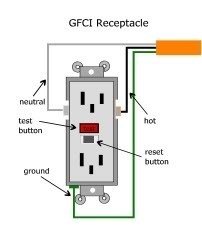GFCI outlets. We see them in our homes, but few people understand what they are, how they work, or why they are there. GFCI stands for Ground Fault Circuit Interrupter.
A GFCI outlet with test and reset buttons
The Shocking Details
I know that during the course of my life, I’ve had my share of electrical shocks, more in my youth than later in life. It could be for a couple of reasons, like because I’m less careless or because our home’s electrical systems have some safeguards we didn’t have when I was a kid.
A GFCI is a device within an electrical circuit that will disconnect or interrupt the circuit in the event that an unbalanced current, or fault, is detected between the hot conductor and the neutral conductor. This imbalance may be caused, for example, by current traveling through a person who has come into contact with the circuit and is in contact with the ground. A GFCI will trip and break the circuit with as little as 5 milliamps of imbalance.
Most shocks are minor and usually don’t result in injury or, worse, death. Your muscles usually react to the shock, causing you to jump or jerk, thus breaking the circuit. In some cases, though, a shock can be much more serious, resulting in tissue damage and burns. In the worst case, an electrical shock can cause heart failure or death.
GFCIs Explained
The sole purpose of a GFCI outlet is to protect people and reduce the risk of electrical shocks. GFCIs are different from the circuit breakers in an electrical panel. Circuit breakers are designed to protect against circuit overload and will trip if there is too much current running through the circuit. Too much current may result in the wiring overheating and causing a fire.
A GFCI outlet has an internal circuit that measures the balance of the current amperage flowing into and out of the circuit. If this circuitry detects a difference in the power on the hot side versus what is returning on the neutral side, the GFCI will trip instantaneously, thus interrupting the power to that circuit.
GFCI outlet diagram
If you accidentally become part of that circuit, the GFCI will detect an imbalance between the hot and neutral (because the power is traveling through you), creating a fault. It will trip the circuit. If you are being shocked, a standard breaker may or may not trip quick enough to save your life. The Consumer Products Safety Commission has provided this GFCI Fact Sheet for additional information.
GFCI Requirements
The National Electrical Code began requiring GFCIs in certain applications as far back as 1968. Over the years, GFCI requirements have included kitchens, bathrooms, laundry areas, unfinished basement spaces, garages, and exterior electrical applications. Most recently, GFCI requirements have included some appliances such as sump pumps, water heaters, and washing machines. Basically, if there is the potential to come into contact with water, a GFCI is required. For more information, you can refer to the 2020 Minnesota Electrical Codes and Standards.
GFCI Outlets and Home Inspections
GFCIs come up for discussion at most home inspections. Our home inspectors document where GFCIs are located in the home as well as where they should be located. We also test and reset all GFCIs to make sure they operate properly. If a GFCI is defective or missing, we document this in your home inspection report.
One of the topics of discussion in older homes is the lack of GFCIs at the proper locations. The question is usually whether or not they are required because the house was built before GFCIs were invented or required. We typically call out the areas that should have GFCIs and stress that, for the relative cost versus the increased safety for your family, GFCIs should be added.
Another issue is GFCIs that are old and will not trip, or, when a home inspector tests and trips the GFCI, it will not reset. This is also a hazard because the GFCI is there to provide protection. When GFCIs are exposed to high humidity or exterior elements, the contacts may corrode, resulting in a GFCI that may not do its job. Our home inspectors will share that GFCIs should be tested (tripped and reset periodically) to ensure they are operating properly.
Summary
GFCI outlets are an important part of your home’s electrical system and provide a high level of safety as long as they are in the proper locations and operate properly. As a homeowner, you can do your part to ensure safe operation by taking the time to test your GFCIs and replace them if they are defective.
At HomePro Inspections, we are trained and always look for these types of issues when inspecting a home. Any issues are documented and recommended for resolution by a qualified professional.
Visit our website to learn more or to schedule your home inspection in the Rochester, Owatonna, and Faribault, MN areas. You can contact us today at (507) 202-8942 or utilize our online “Schedule Now” feature to set up an appointment.


